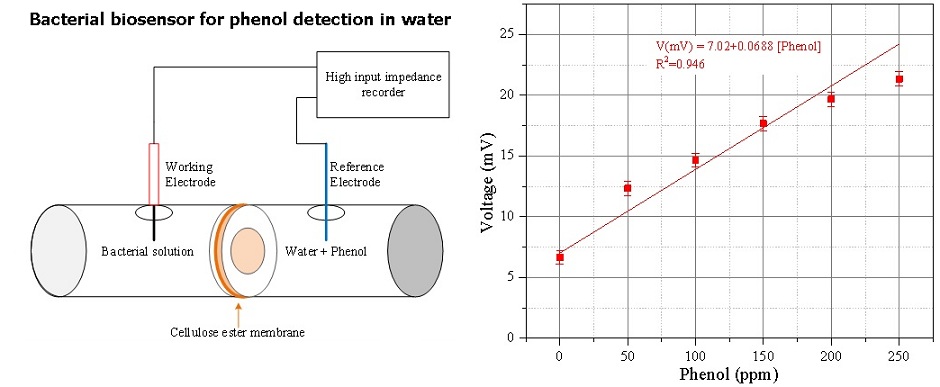Development of Simple Bacterial Biosensor for Phenol Detection in Water at Medium Concentration using Glass Microelectrode
Abstract

Water is one of the most fundamental natural resources in earth. The availability of clean water becomes a global interest. Many human activities result in water pollution. One from many pollution substances in water is phenol. Phenol is a very common residual compound in industrial activity. Extensive use of phenol in industry degrades water quality. Regulation has been set in many countries to prevent further damage to the water resource caused by phenol and limiting phenol concentration in water before released into the environment. Therefor it is importance to develop a sensor which can detect phenol concentration in water to be used as a wastewater quality control system. This paper presents a development of bacterial biosensor using Pseudomonas putida and Pseudomonas fluorescens as a biological sensitive material. The sensor was made from glass micro electrode using Ag/AgCl electrode as reference electrode, silver electrode and cellulose ester. The Pseudomonas putida was entrapped inside the nutrient solution and separated by cellulose ester membrane from water containing phenol. It was found that the Pseudomonas putida in used must be growth in 10 hours to reach its optimum growth condition. Linear relationship between biosensor output voltages to phenol concentration was measured for phenol concentration below 200 ppm. The sensitivity of the developed biosensor was 72mV/ppm for Pseudomonas putida and 68.8 mV/ppm for Pseudomonas fluorescens.
References
Bruce, R. M., Santodonato, J., & Neal, M. W. Toxicol. Ind. Heal. 1987, 3(4), 535–568. 2. Crawford, J., Faroon, O., Wilson, J., Llados, F. T., Garber, K., Paikoff, S. J., & Lumpkin, M. H. Cutan. Ocul. Toxicol. 2008. U.S. Department of Health & Human Services: Atlanta. 3. Drijvers, D., Van Langenhove, H., & Beckers, M. Water Res. 1999, 33(5), 1187–1194. 4. Vončina, D. B., & Majcen-Le-Marechal, A. Dye. Pigment. 2003, 59(2), 173–179. 5. Sato, M., Tokutake, T., Ohshima, T., & Sugiarto, A. T. IEEE Trans. Ind. Appl. 2008, 44(5), 1397–1402. 6. Dombi, A., Ilisz, I., László, Z., & Wittmann, G. Ozone Sci. Eng. 2002. 7. Ji, F., Li, C., & Deng, L. Chem. Eng. J. 2011, 178, 239–243. 8. González, G., Herrera, G., García, M. T., & Peña, M. Bioresour. Technol. 2001, 80(2), 137–142. 9. Heerema, L., Wierckx, N., Roelands, M., Hanemaaijer, J. H., Goetheer, E., Verdoes, D., & Keurentjes, J. Biochem. Eng. J. 2011, 53(3), 245–252. 10. Loh, K. C., & Cao, B. Enzym. Microb. Technol. 2008, 43(1), 1–12. 11. Mordocco, A., Kuek, C., & Jenkins, R. Enzym. Microb. Technol. 1999, 25(6), 530–536. 12. El-Naas, M. H., Al-Muhtaseb, S. a., & Makhlouf, S. J. Hazard. Mater. 2009, 164(2-3), 720–725. 13. Bazrafshan, E., Kord Mostafapour, F., & Jafari Mansourian, H. Heal. Scope. 2013, 2(2), 65–66. 14. Cerdà, V., Cerdà, a., Cladera, a., Oms, M. T., Mas, F., Gómez, E., … Estela, J. M. TrAC - Trends Anal. Chem. 2001, 20(8), 407–418. 15. Christophersen, M. J., & Cardwell, T. J. Anal. Chim. Acta. 1996, 323(1-3), 39–46. 16. Maya, F., Estela, J. M., & Cerdà, V. Talanta. 2010, 81(1-2), 1–8. 17. Rueda, M. E., Sarabia, L. a, Herrero, a, & Ortiz, M. C. 2001, 446, 269–279. 18. Sheikheldin, S. Y., Cardwell, T. J., Cattrall, R. W., Luque De Castro, M. D., & Kolev, S. D. Anal. Chim. Acta. 2000, 419(1), 9–16. 19. Amine, a., Arduini, F., Moscone, D., & Palleschi, G. Biosens. Bioelectron. 2015, In Press, 1–15. 20. Tecon, R., & Van Der Meer, J. R. Sensors. 2008, 8(7), 4062–4080. 21. Liu, C., Yong, D., Yu, D., & Dong, S. Talanta. 2011, 84(3), 766–770. 22. Liu, Z., Liu, Y., Yang, H., Yang, Y., Shen, G., & Yu, R. Anal. Chim. Acta. 2005, 533(1), 3–9. 23. Li, Y. F., Liu, Z. M., Liu, Y. L., Yang, Y. H., Shen, G. L., & Yu, R. Q. Anal. Biochem. 2006, 349(1), 33–40. 24. Stoytcheva, M., Zlatev, R., Gochev, V., Velkova, Z., Montero, G., & Beleño, M. T. Electrochim. Acta. 2014, 147, 25–30. 25. Wang, P., Liu, M., & Kan, J. Sensors Actuators, B Chem. 2009, 140(2), 577–584. 26. Karim, N., & Jin, H. Talanta. 2013, 116, 991–996. 27. Reshetilov, a. N., Iliasov V, P., Filonov, a. E., Gayazov, R. R., Kosheleva, I. a., & Boronin, a. M. Process Biochem. 1997, 32(6), 487–493. 28. Timur, S., Pazarlioǧlu, N., Pilloton, R., & Telefoncu, A. Talanta. 2003, 61(2), 87–93. 29. Velusamy, V., Arshak, K., Korostynska, O., Oliwa, K., & Adley, C. Biotechnol. Adv. 2010, 28(2), 232–54. 30. Conroy, D. J. R., Millner, P. a, Stewart, D. I., & Pollmann, K. Sensors. 2010, 10(5), 4739–55. 31. Deng, T., Li, J.-S., Wang, H., Shen, G.-L., & Yu, R.-Q. J. Immunol. methods. 2005, 299(1-2), 1–8. 32. Mahiudddin, M., Fakhruddin, A. N. M., & Abdullah-Al-Mahin. ISRN Microbiol. 2012, 2012, 1–6. 33. Hasan, S. A., & Jabeen, S. Biotechnol. Biotechnol. Equip. 2015, 29(1), 45–53.
Refbacks
- There are currently no refbacks.









